The joy of roses
To pick a bunch of fragrant roses from your own garden is one of summer’s greatest pleasures - the reward for any effort put in over winter.
Roses don’t look much in winter but as some of summer’s most beautiful and longest flowering shrubs, their season of austerity is easily forgiven. Gardeners who love the colours, forms and fragrances of the worlds most beloved bloom will always find room for roses. It’s time to plant them now.
Roses for picking
There is something about a vase of garden roses that is even lovelier than a shop bought bunch. All roses, both old-fashioned and modern, look beautiful in a vase. But some roses were specifically bred as cutting roses.
These are the Hybrid tea roses with large pointed shape blooms borne singly on top of long straight stems. The best of the classic red picking roses include ‘In Loving Memory’, richly scented ‘Papa Mielland’. In attention-grabbing orange red tones there is Sam McGredy’s esteemed ‘Paddy Stevens’, and newer addition, scented ’Mama Mia’.
Favourite hybrid tea roses among pastel shades are creamy yellow ‘Elina’ and ‘Hamilton Gardens’. ‘Blackberry Nip’ is a must plant if you love deep purple rose with a huge fragrance. At around 1.2m with a bushy habit it fits well in a smaller garden. Another with exceptional perfume is soft pink ‘Aotearoa’.
Roses for colour
Roses come in every colour except true blue. Some gardeners plant roses as part of a specific colour theme, perhaps in an all white garden, as sunshine yellow highlights with blue flowering perennials or a pink themed romantic garden. Others prefer to grow a rainbow of roses. A bright bunch of different coloured roses is a sight to behold.
Some roses blend two or more colours on the one bloom. Bi-coloured favourites include the historic ‘Peace’ rose and eye catching ‘Raspberry Ice’. Striped roses always get noticed. Possibly the oldest striped rose still grown is Rosa ‘Mundi’ dating back to 1581.
‘Nostalgia’ is sumptuous in creamy white edged cherry red, a beautiful modern bush rose bred for high health with glossy, dark leaves.
Floribunda means lots of flowers. Look to the floribunda roses if you want your plants to be smothered in bloom for a mass display of colour in the garden. Floribundas are often shorter and bushier than hybrid tea roses with flowers in large clusters rather than a single rose per stem. The most famous floribunda of them all, ‘Iceberg’ is still widely planted for a showy display of pure white flowers. This extremely healthy rose blooms repeatedly throughout the season but is especially showy in spring and autumn. Bred from Iceberg and carrying the dark green heathy foliage of its parent is ‘Burgundy Iceberg’.
Another floribunda rose to look out for this season is ‘My Precious’ an award winning rose bred by New Zealand’s Bob Matthews with golden buds opening to soft yellow.
Other much loved floribunda roses in white are ‘White Romance’ with especially dark green foliage and ‘Margaret Merrill’ a strongly perfumed rose in creamy white that blooms throughout summer. An excellent choice in clear lemon yellow, ’Serendipity’ is highly disease tolerant and keeps its healthy good looks well into autumn with near continuous flowering. Lovely in lilac, ‘Forget Me Not’ produces mass upon mass of lilac roses with golden stamens.
Breeder Rob Somerfeild has triumphed with a couple of superb new garden roses; the award-winning varieties ‘Little Miss Perfect’ and ‘Strawberry Blonde’. Ginny at Decor Gardenworld in Tauranga reports that these hot recent releases have proven to be incredible doers, especially in the warmer climates, with glossy green super duper foliage and repeat flowering. Compact grower ‘Little Miss Perfect’ has relatively large flowers for its short stature and smothers itself in clear coral blooms. ‘Strawberry Blonde’ is also very showy in shades of golden apricot.
Roses for fragrance
Some of the most potently perfumed roses are those that have been around for centuries, Ancient rose varieties are still grown for their essential oil, a key ingredient in expensive perfumes. They are the great great grandparents of our most fragrant modern roses.
The advantage that ‘modern roses’ (those bred in the last hundred years) have over many old-fashioned roses is that they bloom on much smaller bushes and their generous flowering repeats throughout the season. English rose breeder, David Austin was so successful at bringing the best of the old rose traits back into modern free-flowering roses that his name has become an international brand. Austin roses have the looks of old fashioned roses - and very generously petalled.
More petals often means more perfume. Climbing rose, ‘Compassion’ is no exception to that rule. Bred in 1973 it remains one of most popular climbing roses and has won awards all over the world for its fabulous fragrance.
Hybrid Tea
Aotearoa (pink)
Auckland Metro (creamy white)
Blackberry Nip (purple)
Lasting Love (dusky red)
Memorial Day (orchid pink)
Matawhero Magic (bronze orange)
Pope John Paul II (white)
Scent to Remember (apricot)
Floribunda
Absolutely Fabulous (yellow)
Freisia (bright yellow)
Margaret Merril (cream)
Outta the Blue (magenta)
Scentimental (red/white)
David Austin (English)
Abraham Derby (peach)
Gertrude Jeckyll (bright pink)
Golden Celebration (golden yellow)
Graham Thomas (yellow)
L.D. Braithwaite (red)
Munstead Wood (crimson purple)
The Endeavour (salmon pink)
Climbing
Compassion (apricot pink)
Graham Thomas (yellow)
Madame Alfred Carriere (white)
New Dawn (pink)
Red Flame (dusky red)
Veilchenblau (violet)
Sir Edmund Hillary (cream)
The Chelsea Rose (lemon)
Tropical Essence (new 2019)
Old shrub
(For large gardens)
Blanc Double de Coubert (white)
Buff Beauty (gold)
Golden Wings (yellow)
Ispahan (pink)
Madame Hardy (white)
Madame Isaac Pereire (cerise)
Winter tasks
Winter is the time to act if you want beautiful roses in summer. It’s time now to plant, prune and take precautionary action against pests and diseases.
Planting
Give roses as much sun as possible with ample ventilation to guard against pests and diseases. A good soil for roses is one which holds onto its water. Provided it’s sufficiently drained, with added humus, a clay based soil is ideal. Light sandy soils can also be improved by adding compost. Avoid soil where roses have grown previously.
To plant ‘bare-root' roses in winter, carefully remove the packaging and trim any damaged roots, then soak in a bucket of water while you prepare the ground. Dig a generous planting hole. Position the plant so that the bud union sits just above ground level. Back fill with soil mixed with compost, gently firming the soil around the roots as you go. Water thoroughly after planting. Trim each branch with slanting cuts just above an outward facing bud.
Pruning
July is the main pruning time for roses, but wait until August in cold climates. Using a clean, sharp pair of secateurs, remove dead or decaying wood first. Next remove the oldest branches and those crossing over each other or growing towards the centre of the bush. Shorten the remaining canes to an outward facing bud from which next season’s growth will emerge. Cut on an angle, 5mm above and facing away from the bud. For most modern rose bushes the aim is to end up with three to five thick, well-spaced branches each with three to five buds. Be assured, it’s hard to kill a rose by pruning it.
Winter clean up
After pruning, clear away all leaf debris and surrounding weeds which provide a refuge for the perpetrators of next summers pests and diseases. Spray after pruning with a copper spray mixed with spraying oil. The oil takes care of insect eggs while the copper kills disease spores.
Finding space - six ways to grow more roses
- Roses are flowering shrubs. They don’t have to be restricted to their own formal space. Find room for them among other shrubs and perennials. Add some evergreen topiary shapes for winter interest while the roses sleep. Roses work well with native shrubs.
- Layer it! Standard roses offer instant height in a small space, but unlike trees, they don’t keep getting taller. Underneath they can be planted with another layer of flowers and foliage. Play with annuals for a different look each year, perennials for a more permanent cottage garden effect, or leafy groundcover plants for all year good looks and easy maintenance.
- Use vertical space. Every sunny wall, fence, pergola or post is an opportunity to grow a rose. Alternatively there are lots of modern climbing roses that repeat flower and are easily kept within bounds. Old-world ramblers are greedy for space and tend to be once-only flowering, but if you love the old-fashioned look, train a tall David Austin shrub rose like Graham Thomas as a climber.
- Build an obelisk for a tall bush or climbing rose. While roses sleep through the winter, an attractive obelisk is a feature in its own right.
- Cull poorly performing roses to find room for the ones you want. Ideally do not plant a rose in the same soil where another rose grew. If you cannot adjust the location, dig out the soil and replace it with fresh soil from elsewhere in the garden.
- Grow roses in containers. Some roses specifically bred for tubs and pots with compact growth and repeat flowering. Any rose grown in a container needs extra feeding and watering.

31-May-2019

Peace

In Loving Memory
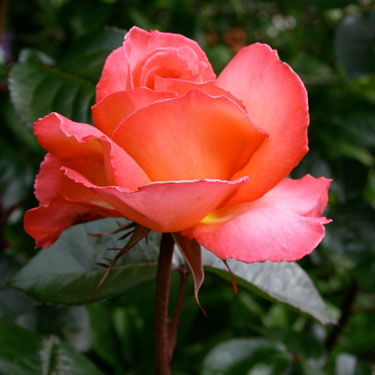
Paddy Stephens

Mama Mia
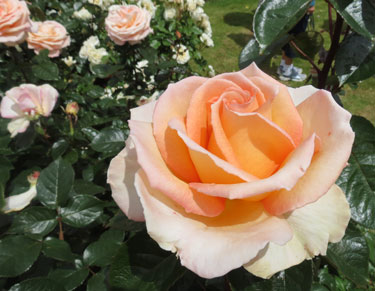
Hamilton Gardens
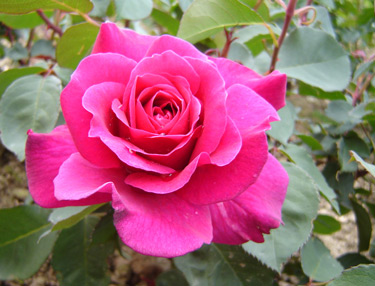
Blackberry Nip
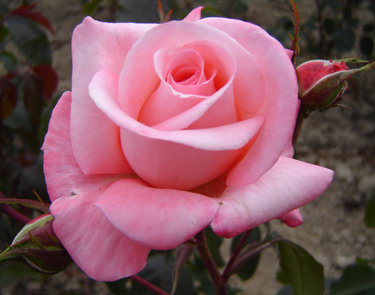
Aotearoa

Nostalgia
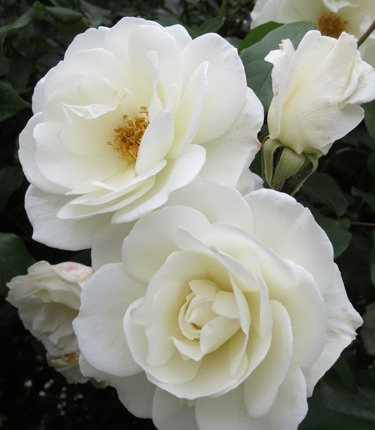
Iceberg

My Precious

